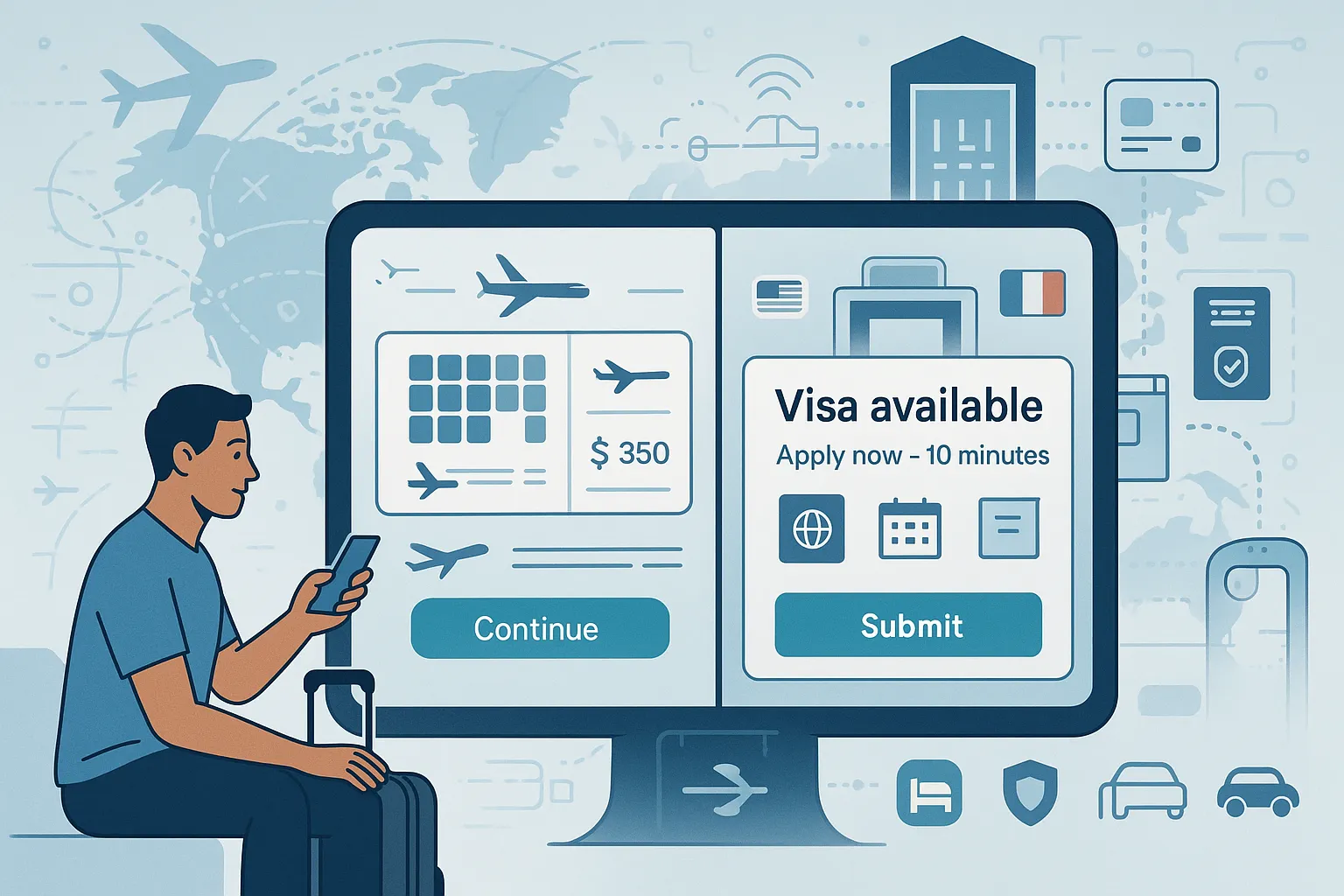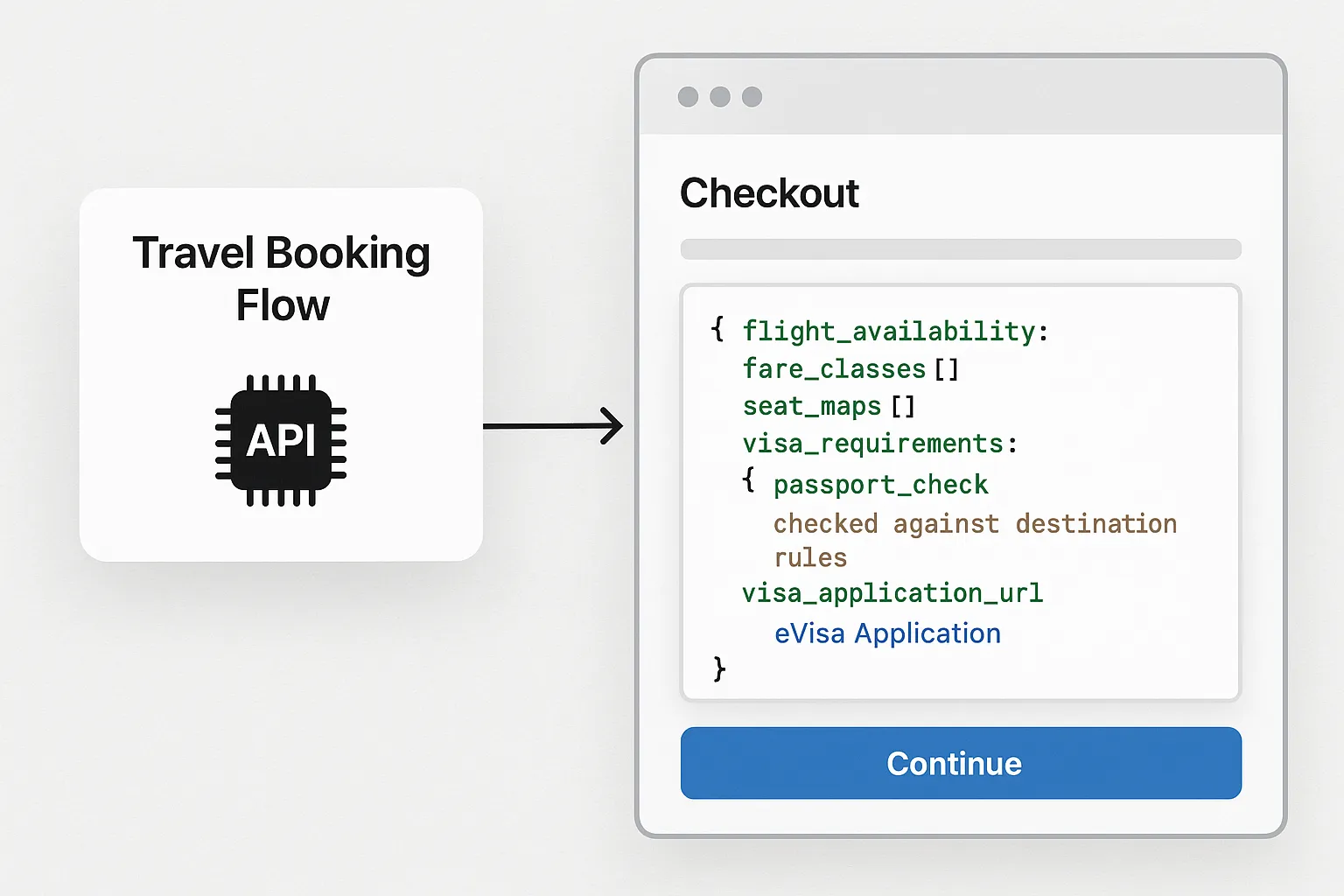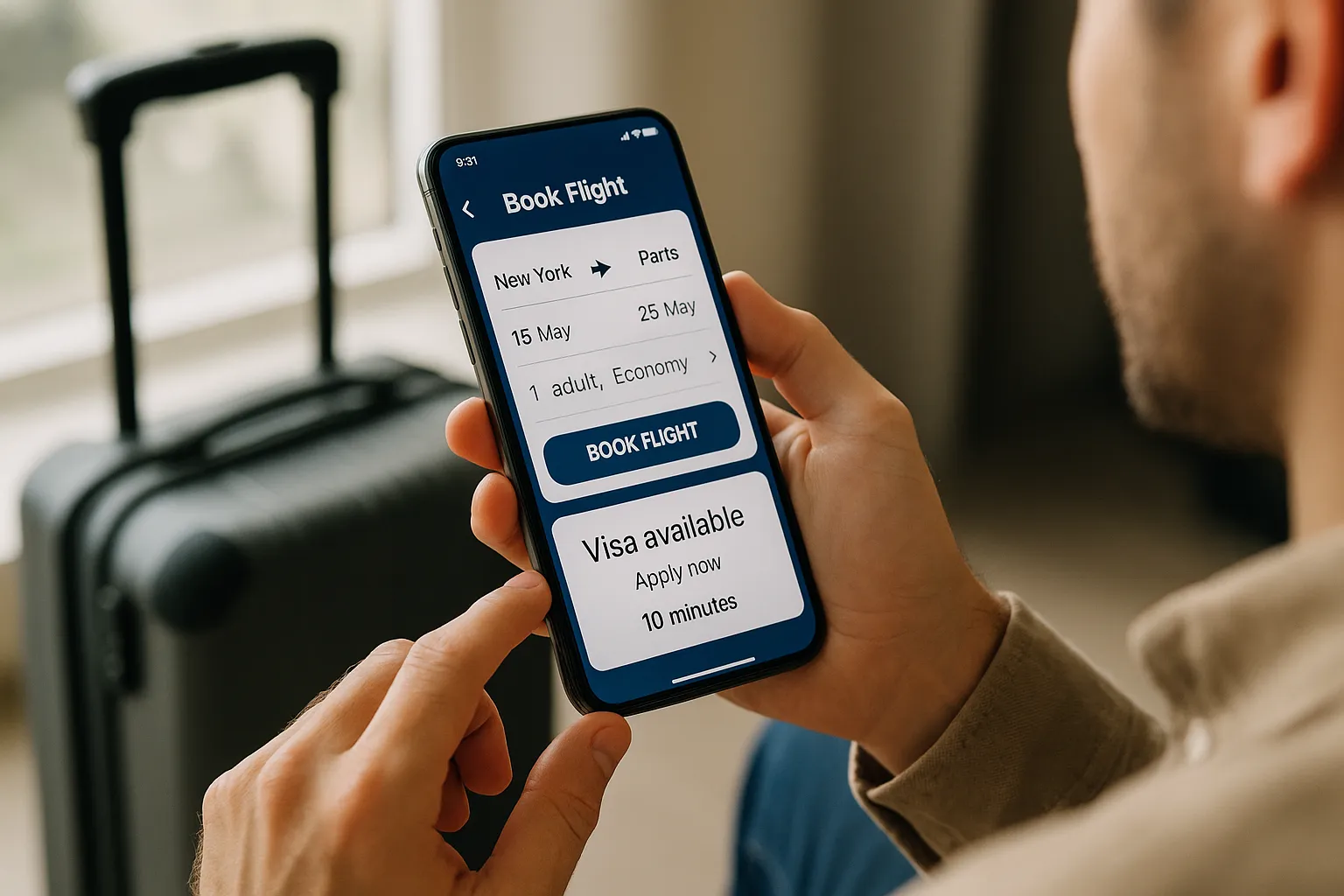Future of Travel APIs: From Flights to Visas in a Single Call

Travel APIs Have Come a Long Way—But There’s Still a Missing Piece
If you build, sell, or operate travel products you already rely on APIs every day. In a few milliseconds you can pull live fares from a GDS, check hotel availability, add an insurance upsell, or push a boarding pass into Apple Wallet. Yet one critical step of the customer journey is still handled off-platform: visas and other border-crossing permits.
That gap is about to close. The newest generation of travel APIs makes it possible to surface visa eligibility, pricing, and even the entire application workflow alongside flights, seats, and bags—in a single call. Below we explore how we got here, why it matters for both travelers and travel sellers, and what to look for when evaluating “Flights-to-Visas” API solutions.
1. The Evolution of Travel APIs in 60 Seconds
-
Phase 1 – Search & Book (2000-2010)
– XML gateways from GDSs expose flight schedules and PNR creation.
– Early hotel aggregators (e.g., Agoda, Expedia Affiliate Network) follow suit. -
Phase 2 – Ancillary Boom (2010-2018)
– Low-cost carriers unlock paid seats, meals, and bags via REST endpoints.
– Fin-tech partners add payments, BNPL, and FX conversion.
– NDC is born, giving airlines richer merchandising capabilities. -
Phase 3 – End-to-End Trip Services (2019-2024)
– Rail, ride-hailing, insurance, carbon offsets, and loyalty points join the mix.
– “Super-apps” in Asia stitch these APIs together to create all-in-one travel wallets. -
Phase 4 – Border Automation (2025 ↗)
– eVisa, ETA, ETIAS, and digital travel credentials become available as plug-and-play services.
– A single response object can now tell you both that seat 7A is available and that your passenger needs an eVisa for the connection through Istanbul—and lets them apply on the spot.
In other words, the border checkpoint is moving into the booking flow.
2. Why Visas Are the Next Big API Opportunity
- Friction kills conversion: 19 percent of travelers abandon a booking when they realize a visa is required but don’t know where to start.
- Regulation won’t wait: By 2026, more than 50 countries will operate mandatory pre-travel authorization schemes (ETIAS, K-ETA, etc.).
- Revenue is on the table: OTAs and airlines that facilitate visa issuance earn service fees averaging US $18 per traveler.
- Customer experience demands it: Today’s travelers expect a single, mobile-first checkout—not a PDF form buried in a consulate website.
Need more numbers? According to IATA, airlines spent an estimated US $700 million last year on compensation and repatriation for passengers denied boarding due to improper documents. Automated visa validation dramatically lowers that risk.
3. From Flights to Visas in One Call: How It Works

-
Query – The client sends a standard availability or pricing request (flight search, itinerary build, etc.) along with two additional parameters: passenger nationality and passport expiry date.
-
Enrichment – The travel API fetches real-time visa rules (think Timatic-style data, but machine readable) and annotates the itinerary response with:
– Visa requirement status (Yes/No/Conditional)
– Visa type (eVisa, ETA, traditional, transit)
– Processing time & cost
– Inline link or widget ID to launch the application flow. -
Application – If an eVisa is available, the user completes a short form, uploads documents, and pays—all inside your app or website.
– Under the hood, a visa-specific API (like the one offered by SimpleVisa) submits data to the correct government endpoint, monitors status, and returns the approval PDF or QR code. -
Fulfilment & Monitoring – The approved visa is attached to the PNR and stored in the traveler’s wallet. Webhooks notify both the customer and the booking platform of status changes, expirations, or revocations.
No dev wants to juggle six different government integrations, obscure SOAP envelopes, and timezone-dependent SLA windows. Abstracting those complexities into a single, normalized API call is what makes this approach so transformative.
4. Technical Checklist When Evaluating a Visa API
| Capability | Why It Matters |
|---|---|
| REST/GraphQL endpoints with versioning | Smooth integration into existing micro-services |
| ISO 27001 & GDPR compliance | You’re handling sensitive PII; audits are non-negotiable |
| Real-time rules engine | Visa regulations change daily—static tables won’t cut it |
| Webhook & webhook retry logic | Keep your booking flow updated without polling |
| White-label UI components | Speed to market for teams without front-end bandwidth |
| Revenue-share or markup flexibility | Aligns with your ancillary strategy |
| Sandbox with sample passports | Facilitates rapid prototyping before production |
For a deeper dive on the underlying mechanics, see our explainer “How eVisa APIs Work: Step by Step”.
5. Business Outcomes You Can Measure
- Higher Conversion – OTAs testing visa widgets at checkout report up to +6 % lift in completed bookings on routes with complex entry rules.
- Ancillary Revenue – Depending on your margin strategy, each eVisa sold can add US $10–25 of pure profit. Airlines have seen visa fees overtake seat-selection revenue on certain long-haul markets.
- Reduced Customer Support Load – Fewer “Do I need a visa?” calls and chargebacks related to denied boarding.
- Compliance & Risk Mitigation – Automated document checks protect carriers from fines (up to €3,000 per inadmissible passenger in the EU).
- Data Insight – Aggregated visa-demand data can inform route planning and marketing spend.
6. Real-World Use Cases
- Global OTA – Embeds SimpleVisa’s widget in the payment step; average order value increases 11 percent.
- Full-Service Airline – Adds a visa eligibility banner to post-booking emails, converting 28 percent of passengers and reducing airport document issues by 40 percent.
- Corporate TMC – Uses API-only approach to pre-screen multi-segment itineraries for 200,000 frequent travelers, automatically flagging when passports are within six months of expiry.
- Super-app / Wallet – Surfaces visa status alongside FX preload and lounge vouchers, adding a new revenue line without additional KYC obligations.

7. Implementation Roadmap
- Scope – Identify top O&D pairs with high visa friction (India ↔ Thailand, UK ↔ Turkey, US ↔ Vietnam, etc.).
- Choose Integration Mode
– No-code widget: Live in a week—ideal for proof of concept.
– Full API: 2–6 weeks depending on your dev cycle. - Map Customer Journey – Decide where to surface visa info: search results, cart, confirmation email, or all three.
- Set Revenue Model – Markup, fixed fee, or revenue share? A/B test to find the sweet spot.
- Train CS & Ops Teams – Provide a clear handoff path for escalations; most questions will drop by themselves.
- Launch & Iterate – Monitor key KPIs: attach rate, approval rate, processing SLA, and NPS.
Need help? Our solutions engineers have pre-built templates for Amadeus, Sabre, Duffel, Wego, and custom stacks.
8. Looking Ahead: Biometrics, Digital Identity, and Smart Borders
The single-call vision is only the beginning. Over the next five years we expect to see:
- Digital Traveler Credentials (DTC) stored in mobile wallets, allowing visa APIs to auto-populate forms with verified data.
- Biometric liveness checks embedded in-app, satisfying governments that previously required in-person appointments.
- One-click re-use of documents across multiple trips and countries, as blocs such as ASEAN and Mercosur harmonize standards.
- Predictive compliance engines that adjust itineraries in real time when new border restrictions (health, security, climate) emerge.
Platforms that integrate visas today will be perfectly positioned to plug these next-gen features into the same pipeline tomorrow.
9. Key Takeaways
- Travel APIs have evolved from basic booking tools to full-stack trip orchestrators.
- Visas are the final major pain point that can now be solved programmatically.
- A single enriched response adds value, reduces risk, and generates new revenue.
- Look for partners offering robust security, real-time rules, and flexible commercial models.
- Early adopters are already seeing conversion lifts and million-dollar ancillary lines.
Ready to see it in action? Request a demo or explore our primer on travel visa document systems to learn how SimpleVisa can drop seamlessly into your existing booking flow.
Border hurdles shouldn’t cost you bookings—or customers. Bring flights and visas together, and make travel truly simple.